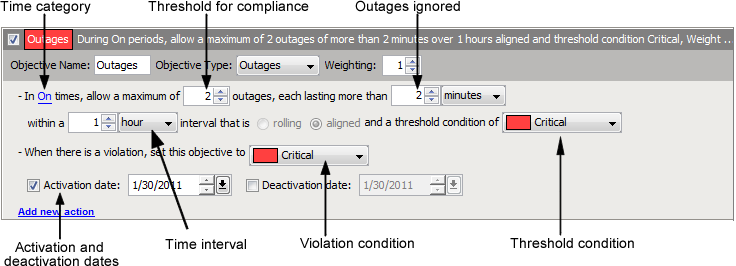5.7 Defining an Outages Objective
An outage occurs when an element goes below a specified condition for a specified amount of time during a period specified. An outage continues as long as the element condition remains equal to or greater than the threshold condition.
Typically when an element’s condition becomes critical, an outage occurs.
If an element reaches or exceeds the threshold condition when the element is scheduled to be unavailable, then the incident is not counted as an outage.
The outages objectives sets the maximum number of outages (of specified duration) allowed to be compliant within the selected objective interval of time. The threshold setting defaults to Critical.
For example: In Peak times, allow a maximum of 10 outages, each lasting no more than 60 seconds within a 1 hour interval that is aligned and a threshold condition of Major.
Figure 5-2 Outages Objective with Default Options

When defining the Outages objective, set the following:
-
Time Category: Time category specifies when to collect data to use to define outages. The actual time associated with the time category is specified in the calendar defined for the SLA with which the objective is associated.
Threshold for Compliance: The threshold for compliance is the number of outages allowed for the objective to still be in compliance. If that number is exceeded, then the objective might be out of compliance. The default is 0, which means that any time there is an outage it is counted against compliance.
Outages Ignored: By default, every outage regardless of the amount of time it lasts is considered against compliance. Specify an amount of time that an outage must meet or exceed to be counted as an outage for compliance. Specify a whole number of seconds, minutes, or hours.
This option allows discounting minor and occasional blips in performance and target True performance issues. However, if every outage is important and should result in a breach alarm, then leave the default of 0 outages lasting 0 seconds.
Time Interval: The time period in which to calculate availability. For more information, see Section 5.4, Understanding Time Intervals.
Threshold Condition: The threshold is the condition at which the objective considers the element to be unavailable or out. That is, the time that the element is at or below this condition is considered an outage.
The default is Critical. This default can be changed.
When an element has a condition of either Unknown or Unmanaged, then it is treated as available and not experiencing an outage.
Violation Condition: When the objective is out of compliance, the condition of the objective is Critical. You can change this condition. However, changing this condition has absolutely no impact on the state of the objective at any other time (for example, when it is halfway to the failure state). The state of a failed objective has absolutely no impact on the state of the SLA, which is determined by health scores of objective and not state of objectives.
When an objective is halfway to failure, the state of the objective always defaults to Major. For example, if 6 outages are allowed, when the 3 outage occurs, the objective state changes to Major.
Activation and Deactivation Dates: (Optional) Indicates when the objective starts and ends. For more information, see Understanding Activation and Deactivation Dates.